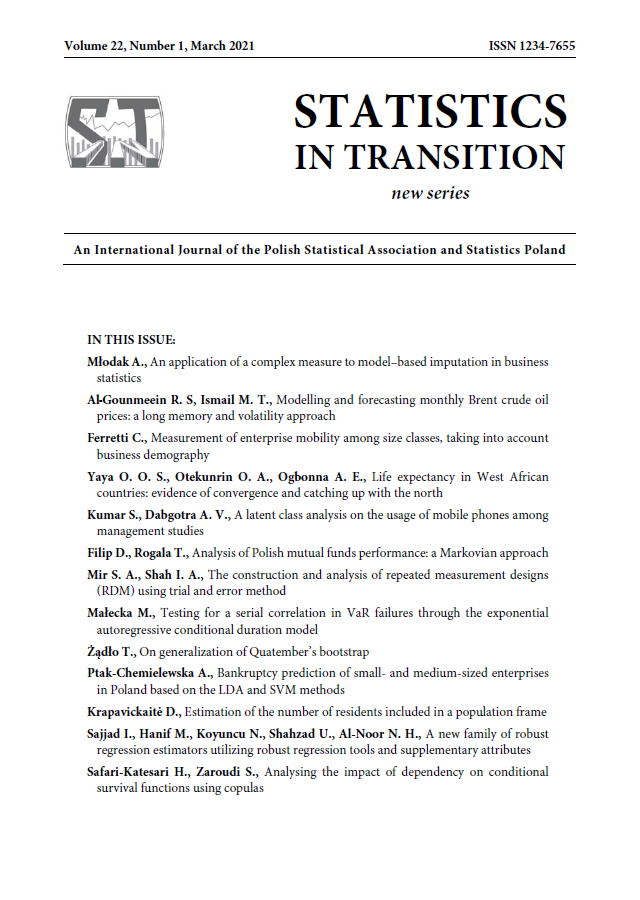ARTICLE
ABSTRACT
Although regulatory standards, currently developed by the Basel Committee on Banking Supervision, anticipate a shift from VaR to ES, the evaluation of risk models currently remains based on the VaR measure. Motivated by the Basel regulations, we address the issue of VaR backtesting and contribute to the debate by exploring statistical properties of the exponential autoregressive conditional duration (EACD) VaR test. We show that, under the null, the tested parameter lies at the boundary of the parameter space, which can profoundly affect the accuracy of this test. To compensate for this deficiency, a mixture of chi-square distributions is applied. The resulting accuracy improvement allows for the omission of the Monte Carlo simulations used to implement the EACD VaR test in earlier studies, which dramatically improves the computational efficiency of the procedure. We demonstrate that the EACD approach to testing VaR has the potential to enhance statistical inference in most problematic cases – for small samples and for those close to the null.
KEYWORDS
VaR backtesting, exponential autoregressive conditional duration, boundary of the parameter space, test size, test power
REFERENCES
ACERBI, C., SZEKELY, B., (2014). Backtesting Expected Shortfall, Risk, November.
BASEL COMMITTEE ON BANKING SUPERVISION, (1996). Amendment to the capital accord to incorporate market risks: Technical document, available online: http://www.bis.org/publ/bcbs24.pdf (accessed June 4, 2018).
BASEL COMMITTEE ON BANKING SUPERVISION, (2012). Fundamental Review of the Trading Book: Technical document, available online: http://www.bis.org/publ/bcbs219.pdf (accessed June 4, 2018).
BASEL COMMITTEE ON BANKING SUPERVISION, (2013). Fundamental Review of the Trading Book: A Revised Market Risk Framework: Technical document, available online: http://www.bis.org/publ/bcbs265.pdf (accessed June 4, 2018).
BASEL COMMITTEE ON BANKING SUPERVISION, (2014). Fundamental Review of the Trading Book: Outstanding Issues: Technical document, available online: http://www.bis.org/bcbs/publ/d305.pdf (accessed June 4, 2018).
BASEL COMMITTEE ON BANKING SUPERVISION, (2015). Fundamental review of the trading book - interim impact analysis: Technical document, available online: http://www.bis.org/bcbs/publ/d346.pdf (accessed June 4, 2018).
BASEL COMMITTEE ON BANKING SUPERVISION, (2016). Minimum capital requirements for market risk: Technical document, available online: http://www.bis.org/bcbs/publ/d352.pdf (accessed June 4, 2018).
BASEL COMMITTEE ON BANKING SUPERVISION, (2017). High-level summary of Basel III Reforms: Technical document, available online: https://www.bis.org/bcbs/publ/d424_hlsummary.pdf (accessed June 4, 2018).
BERKOWITZ, J., (2001). Testing Density Forecasts with Applications to Risk Management, J Bus Econ Stat, Vol. 19(4), pp. 465–474, doi: https://dx.doi.org/10.1198/07350010152596718.
BERKOWITZ, J., CHRISTOFFERSEN, P., PELLETIER, D., (2011). Evaluating Valueat- Risk Models with Desk-Level Data, Manage Sci, Vol. 12(57), pp. 2213–2227, doi: https://dx.doi.org/10.1287/mnsc.1080.0964.
CANDELON, B., COLLETAZ, G., HURLIN, C., TOKPAVI, S., (2011). Backtesting Value-at-Risk: a GMM duration-based test, J Financ Economet, Vol. 9(2), pp. 314– 343, doi: https://doi.org/10.1093/jjfinec/nbq025.
CHEN, J. M., (2014). Measuring market risk under the Basel accords: VaR, stressed VaR, and expected shortfall. Aestimatio, The IEB International Journal of Finance, Vol. 8, pp.184–201, doi: https://doi.org/10.2139/ssrn.2252463.
CHRISTOFFERSEN, P., (1998). Evaluating Interval Forecasts, Int Econ Rev, Vol. 39(4), pp. 841–862, doi: https://doi.org/10.2307/2527341.
CHRISTOFFERSEN, P., PELLETIER, D., (2004). Backtesting Value-at-Risk: A Duration-Based Approach, J Financ Economet, Vol. 2(1), pp. 84–108, doi: https://doi.org/10.1093/jjfinec/nbh004.
COLLETAZ, G., HURLIN, C., PERIGNON, C., (2013). The Risk Map: a New Tool for Risk Management, J Bank Financ, Vol. 37(10), pp. 3843–3854, doi: https://doi.org/10.1016/j.jbankfin.2013.06.006.
DUFOUR, J. M., (2006). Monte Carlo Tests with Nuisance Parameters: A General Approach to Finite-Sample Inference and Nonstandard Asymptotics, J Econometrics, Vol. 133(2), pp. 443–477, doi: https://doi.org/10.1016/j.jeconom.2005.06.007.
ENGLE, R. F., RUSSEL, J. R., (1998). Autoregressive Conditional Duration: A New Model for Irregularly Spaced Transaction Data, Econometrica, Vol. 66(5), pp. 1127–62, doi: https://doi.org/10.2307/2999632.
FISSLER, T., ZIEGEL, J. F., GNEITING, T., (2016). Expected shortfall is jointly elicitable with value at risk – Implications for backtesting, Risk, Vol. 29, pp. 58–61.
FISSLER, T., ZIEGEL, J. F., (2016). Higher order elicitability and Osband’s principle, Ann Stat, Vol. 44(4), pp. 1680–707, doi: https://doi.org/10.1214/16-AOS1439.
GNEITING, T., (2011). Making and evaluating point forecasts, J Am Stat Assoc, Vol. 106(494), pp. 746–762, doi: https://doi.org/10.1198/jasa.2011.r10138.
GORDY, M. B., MCNEIL, A. J., (2018). Spectral Backtests of Forecast Distributions with Application to Risk Management, in: Finance and Economics Discussion Series 2018-021, Board of Governors of the Federal Reserve System, Washington.
HURLIN, CH., TOKPAVI, S., (2007). Backtesting value-at-risk accuracy: a simple new test, J Risk, Vol. 9(2), pp. 19–37, doi: https://doi.org/10.21314/JOR.2007.148.
KRATZ, M., LOK, Y. H., MCNEIL, A. J., (2018). Multinomial VaR backtests: A simple implicit approach to backtesting expected shortfall, J Bank Financ, Vol. 88, pp. 393– 407, doi: https://doi.org/10.1016/j.jbankfin.2018.01.002.
LECCADITO, A., BOFFELLI, S., URGA, G., (2014). Evaluating the Accuracy of Valueat- Risk Forecasts: New Multilevel Tests, Int J Forecasting, Vol. 30(2), pp. 206–216, 014.doi: https://doi.org/10.1016/j.ijforecast.2013.07.
LOPEZ, J., (1999). Methods for Evaluating Value-at-Risk Estimates, FRBSF Economic Review, Vol. 2, pp. 3–17.
MAŁECKA, M., (2018). Exponential Autoregressive Conditional Duration Approach to Testing VaR, in: ICoMS 2018: Proceedings of the 2018 International Conference on Mathematics and Statistics, ACM, New York, pp. 6–10, doi: https://doi.org/10.1145/3274250.3274254.
PAJHEDE, T., (2017). Backtesting Value-at-Risk: A Generalized Markov Test, J Forecast, Vol. 36(5), pp. 597–613, doi: https://doi.org/10.1002/for.2456.
PELLETIER, D., WEI, W., (2016). The geometric-VaR backtesting method, J Financ Economet, Vol. 14(4), pp. 725–745, doi: https://doi.org/10.1093/jjfinec/nbv015.
SELF, S. F., LIANG, K. Y., (1987). Asymptotic Properties of Maximum Likelihood Estimators and Likelihood Ratio Tests Under Nonstandard Conditions, J Am Stat Assoc, Vol. 82(398), pp. 605–610, doi: https://doi.org/10.2307/2289471.
WIED, D., WEI, G. N. F., ZIGGEL, D., (2016). Evaluating Value-at-Risk forecasts: a new set of multivariate backtests, J Bank Financ, Vol. 72, pp. 121–132, doi: https://doi.org/10.1016/j.jbankfin.2016.07.014.
